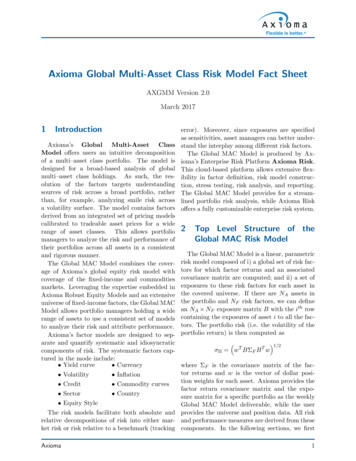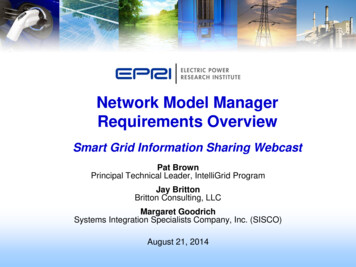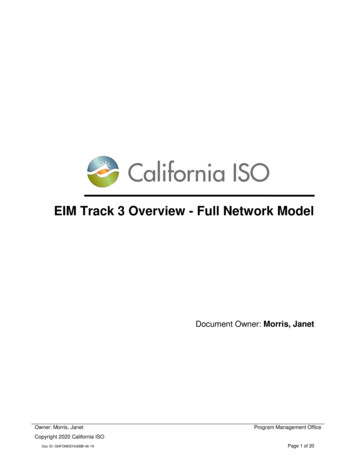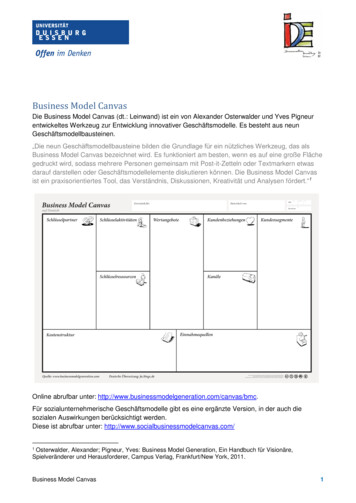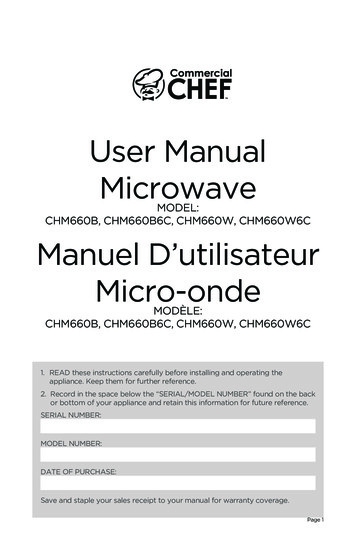
Transcription
User ManualMicrowaveMODEL:CHM660B, CHM660B6C, CHM660W, CHM660W6CManuel D’utilisateurMicro-ondeMODÈLE:CHM660B, CHM660B6C, CHM660W, CHM660W6C1. READ these instructions carefully before installing and operating theappliance. Keep them for further reference.2. Record in the space below the “SERIAL/MODEL NUMBER” found on the backor bottom of your appliance and retain this information for future reference.SERIAL NUMBER:MODEL NUMBER:DATE OF PURCHASE:Save and staple your sales receipt to your manual for warranty coverage.Page 1
Page 2
CONTENTSSAFETY INFORMATIONPrecautions to Avoid Possible Exposure to Excessive Microwave Energy.4A Special Note on Arcing.4Addendum. 4Important Safety Instructions. 5Grounding Instructions. 7Utensil Guide for the Microwave.8-9SET UP & USESpecifications. 10Installation Guide. 10Parts & Features.11Control Panel.11Operation Instructions.12Defrosting The Food.12Cooking Technique.13CLEANING & CARE.13-14TROUBLESHOOTING & WARRANTYBefore You Call For Service. 14Customer Service. 14Troubleshooting.15Limited Warranty.161. READ these instructions carefully before installing and operating theappliance. Keep them for further reference.2. Record in the space below the “SERIAL/MODEL NUMBER” found on the backor bottom of your appliance and retain this information for future reference.SERIAL NUMBER:MODEL NUMBER:DATE OF PURCHASE:Save and staple your sales receipt to your manual for warranty coverage.Page 3
SAFETY INFORMATIONDANGERDANGER - Immediate hazardswhich WILL result in severepersonal injury or deathWARNINGWARNING - Hazards or unsafepractices which COULD result insevere personal injury or deathCAUTIONCAUTION - Hazards or unsafepractices which COULD result inminor personal injuryPRECAUTIONS TO AVOIDPOSSIBLE EXPOSURE TOEXCESSIVE MICROWAVE ENERGY1. D o not attempt to operate this oven with the door open sinceopen-door operation can result in harmful exposure to microwave energy. Itis important not to defeat or tamper with the safety interlocks.2. Do not place any object between the oven front face and the door or allowsoil or cleaner residue to accumulate on sealing surfaces.3. D o not operate the oven if damaged. It is particularly important that theoven door closes properly and that there is no damage to the:1. DOOR (bent)2. HINGES AND LATCHES (broken or loosened)3. DOOR SEALS AND SEALING SURFACES4. T he oven should not be adjusted or repaired by anyone except properlyqualified service personnel.A SPECIAL NOTE ON ARCING“Arcing” refers to the presence of sparks inside the microwave oven.It can be caused by: Metal or foil touching the inside wallsof the oven. F oil not closely molded to food, whereedges have been left sticking up. S mall metal parts such as twist-ties,poultry pins, or gold-rimmed dishes. R ecycled paper towels which maycontain small amounts of metal.CAUTIONIF YOU SEE SPARKS IN YOURMICROWAVE OVEN,IMMEDIATELY TURN TIMER TOOFF CEASE COOKING ANDCORRECT THE PROBLEM.ADDENDUMIf this product is not maintained in a good state of cleanliness, its surfacecould be degraded. This could affect the lifespan of the product and lead to adangeroussituation.Page 4
SAFETY INFORMATIONIMPORTANT SAFETY INSTRUCTIONSWARNINGWhen using electrical appliances, basic safetyprecautions should be followed, including the followingWARNING: To reduce the risk of burns, electric shock, fire, andinjury to persons or exposure to excessive microwave energy:1. Read all instructions before using the appliance.2. Read carefully and follow the specific “Precautions to avoid possibleexposure to excessive microwave energy” on page 3.3. This appliance must be grounded. Connect only to properlygrounded outlet. See “GROUNDING INSTRUCTIONS” on page 6.4. Install or position this appliance only in accordance with theprovided installation instructions on page 9.5. Some products such as whole eggs and sealed containers -forexample, closed glass jars- can potentially explode and should notbe heated in this oven.6. Use this appliance only for the intended uses as described in thismanual. This type of oven is specifically designed to heat, cook, ordry food. It is not designed for industrial or laboratory use. Do notuse corrosive chemicals or vapors in this appliance.7. As with any appliance, close supervision is necessary when used bychildren.8. To reduce the risk of fire in the oven cavity; Do not overcook food. Carefully attend the appliance when paper,plastic, or other combustible materials are placed inside the oven tofacilitate cooking. Remove wire twist-ties from paper or plastic bags before placingbag in oven. If materials inside the oven ignite, keep oven door closed, turn ovenoff, and disconnect the power cord or shut off power at the fuse orcircuit breaker panel. Do not use the cavity for storage purpose. Do not leave paperproducts, cooking utensils or food inside the cavity when not in use.9. Liquids, such as water, coffee, or tea can be overheated beyondthe boiling point without appearing to be boiling due to surfacetension of the liquid. Visible bubbling or boiling when the container isremoved from the microwave oven is not always present. This couldresult in very hot liquids suddenly boiling over when a spoon orother utensil is inserted into the liquid.10. Do not heat oil or fat for deep-frying. It is difficult to control thetemperature of oil in a microwave oven.11. Foods with heavy skins such as potatoes, whole squash, apples andchestnuts should be pierced with a fork or the tip of a sharp knifebefore cooking.Page 5
SAFETY INFORMATION12. The contents of feeding bottles and baby food jars should be stirredor shaken and the temperature should be checked before serving inorder to avoid burns.13. Cooking utensils may become hot because of heat transferred fromthe heated food. Pot holders may be needed to handle the utensil.14. Do not cover or block any openings on the appliance.15. Do not store or use this appliance outdoors. Do not use this productnear water, for example, near a kitchen sink, in a wet basement, neara swimming pool, or similar locations.16. Do not operate this appliance if the cord or plug is damaged, if it isnot working properly, or if it has been damaged or dropped.17. Do not immerse cord or plug in water. Keep cord away from heatedsurfaces. Do not let cord hang over the edge of a table or counter.18. Use only thermometers, specifically designed for use in microwaveovens.19. Be certain the glass tray and roller rings are in place beforeoperating the oven20. This appliance should be serviced only by qualified servicepersonnel. Contact nearest authorized service facility forexamination, repair, or adjustment.21. When cleaning sealing surfaces of the oven, such as the door jamb,use only mild, nonabrasive soaps, or mild detergents applied with asponge or soft cloth.SAVE THESE INSTRUCTIONSHOUSEHOLD USE ONLYFEDERAL COMMUNICATIONS COMMISSIONRADIO FREQUENCY INTERFERENCE STATEMENTWARNING: This equipment generates and uses ISM frequency energy and if not installedand used properly, that is in strict accordance with the manufacturer’s instructions, maycause interference to radio and television reception. It has been type-tested and foundto comply with limits for an ISM Equipment pursuant to part 18 of FCC Rules, which aredesigned to provide reasonable protection against such interference in a residentialinstallation. However, there is no guarantee that interference will not occur in a particularinstallation. If this equipment does cause interference to radio or television reception, whichcan be determined by turning the equipment off and on, the user is encouraged to try tocorrect the interference by one or more of the followings. Reorient the receiving antenna of radio or television. Relocate the Microwave oven with respect to the receiver. Move the microwave oven away from the receiver. Plug the microwave oven into a different outlet so that microwave oven and receiver areon different branch circuits.THE MANUFACTURER is not responsible for any radio or TV interference caused byUNAUTHORIZED MODIFICATION to this microwave oven. It is the responsibility of the userto correct such interference.Page 6
SAFETY INFORMATIONGROUNDING INSTRUCTIONSELECTRICAL REQUIREMENTSThe electrical requirements are a 120 volt 60 Hz, AC only, 20 amp. It is recommendedthat a separate circuit serving only the oven be provided. The oven is equippedwith a 3-wire cord having a 3-prong grounding plug. It must be plugged into a wallreceptacle that is properly installed and grounded.This appliance must be grounded. In the event of an electrical short circuit,grounding reduces risk of electric shock by providing an escape wire for the electriccurrent. The cord provided with this appliance is equipped with a grounding wire anda grounding plug. The plug must be plugged into an outlet that is properly installedand grounded. Do not attempt to defeat this safety feature by modifying the plug inany way.WARNINGImproper use of the groundingplug can result in a risk of electric shock.Consult a qualified electrician or serviceman if:1) The grounding instructions are not completely understood.2) You are unsure that the appliance is properly grounded.3) You have any questions about the grounding or electrical instructions.POWER SUPPLY CORD1. A short power supply cord is provided to reduce the risk of becoming entangled inor tripping over a longer cord.2. If the power supply cord is too short, do not use an extension cord. Have aqualified electrician or serviceman to install an outlet near the appliance.3. If it is absolutely necessary to use longer cord sets or an extension cord, extremecare must be exercised.a) Use only a grounding type 3-wire extension cord that has a 3-blade groundingplug and a 3-slot receptacle that will accept the plug on the appliance.b) The marked electrical rating of the cord set or extension cord must equal toor greater than the electrical rating of the appliance. The longer cord should bearranged so that it will not drape over the counter top or table top where it canbe pulled on by children or tripped over unintentionally.NOTE: Neither Commercial Chef nor the dealer can accept any liability for damage to the oven orpersonal injury resulting from failure to observe the electrical connection procedures.Page 7
SAFETY INFORMATIONUTENSIL GUIDE FOR THE MICROWAVEThis section lists which utensils can be used in the microwave, which have limiteduse, and which should not be used in the microwave at all.CAN USECAN NOT USELIMITED USE M icrowave browningdish: For browning theexterior of food suchas steaks, chops, orpancakes. Follow thedirections provided withyour browning dish. G lass jars and bottles:Regular glass is toothin to be used in amicrowave. It canshatter, causing damageand injury. A luminium foil: Smooth,narrow strips of foilmay be used to shielddelicate areas on fooditems like drumsticksand wings to preventovercooking. Keep allaluminium foil at least 1inch from the side wallsand the door of themicrowave. M icrowaveable plasticwrap: For retainingsteam. Leave a smallopening for some steamto escape. Avoid placingit directly on the food. P aper towels andnapkins: To absorbexcess moisture andprevent spattering.Use for shortterm heating andcovering. Check formanufacturer’s labels forany special instructions. O ven-proof glass, glassceramic bowls anddishes: For use in themicrowave oven. P aper plates and cups:For short-term heatingat low temperatures. Donot use recycled paper,which may containmetal and could ignite.NOTE: Recycled paper maycontain metal which couldignite so please be careful.Page 8 P aper bags: These area fire hazard, they canabsorb heat and burn.Only use popcorn bagsthat are designed formicrowave use. S tyrofoam plates andcups: These can meltand leave a harmfulchemical residue onfood. P lastic storage and foodcontainers: Containersmeant for cold storage,such as margarinetubs, can melt in themicrowave. M etal utensils: Thesecan damage yourmicrowave oven.Remove all metal fromfood and containersbefore cooking. P archment paper: Useas a cover to preventspattering or as a wrapfor steaming.NOTE: Using too muchfoil can damage your oven. C eramic, porcelain, andstoneware: Only if theyare labelled “MicrowaveSafe”. If they are notlabelled, test them tomake sure they can beused safely. P lastic: Use only iflabelled “MicrowaveSafe”. Use with carebecause the plastic cansoften from the heatof the food and someplastic can melt.
SAFETY INFORMATIONCAN USE W ax paper: To preventspattering. T hermometers:Only those labelled“Microwave Safe” andfollow all directions.Check the temperatureof food in severalplaces. Conventionalthermometers may beused on microwavedfood once the food hasbeen removed from theoven.CAN NOT USE A luminium tray: Maycause arcing. Avoidaluminium foil this maycause arcing. T ake-out carton withmetal handle: May causearcing. Transfer foodto a microwave-safecontainer.LIMITED USE S traw, wicker, andwood: For shortterm heating, such aswarming dinner rolls fora few seconds. Basketsand bowls may beflammable. M etal or metaltrimmed utensils: Metalcookware, metal trim,and metallic glazesmay cause arcing. Alsoavoid metal skewers andmetal twisties. W ood: Wood will dryout when used in themicrowave oven andmay split or crack.Wooden bowls, basketsand board will dryout and may split orcrack when used in themicrowave. R ecycled paper towels,paper plates and cups:May contain metal andcould ignite.NOTE: To test if a dish issafe for microwaving, placethe empty dish in the ovenand microwave on HIGH for30 seconds. A dish whichbecomes very hot shouldnot be used.Page 9
SET UP & USESPECIFICATIONS Power Consumption: 120V 60Hz, 850WMWO Power: 600WOperation Frequency: 2450MHzOutside Dimensions (H x W x D): 10 5/16” x 17 13/16” x 13 5/8”Oven Cavity Dimensions (H x W x D): 7 13/16” x 12 3/8” x 11 9/16”Oven Capacity: 0.6 cubic feetNet Weight: Approx. 23.1 lbs.INSTALLATION GUIDE1. Make sure that all the packing materials are removed from the inside of the door.2. Check the oven for any damage, such as misaligned or bent door, damaged doorseals and sealing surfaces, broken or loose door hinges and latches, and dentsinside the cavity or on the door. If there is any damage, do not operate the oven.Contact qualified service personnel.3. This microwave oven must be placed on a flat, stable surface capable ofsupporting the weight of the oven plus the heaviest food likely to be cooked in theoven.4. Do not place the oven where heat, moisture, or high humidity are generated, ornear combustible materials.5. To function correctly, the oven must have sufficient airflow on all sides. Allow 8” ofspace above the oven, 4” at back, and 2” at both sides. Do not cover or block anyopenings on the appliance. Do not remove feet on which oven stands.6. Do not operate the oven without glass tray, roller support, and shaft in their properpositions.7. Make sure that the power supply cord is undamaged and doesnot run under the oven or over any hot or sharp surface.8. T he socket must be readily accessible so that the cord can bequickly reached and easily unplugged in an emergency.NOTE: Do not remove the mica plate covering the wave guide in the ovencavity.RADIO OR TV INTERFERENCEIf the microwave oven causes interference to your radio or TV,1. Check that the microwave oven is on a different circuit2. Relocate the radio or TV as far away from the oven as possible3. Check position and signal of receiving antenna.4. Clean door and sealing surface.5. Move the microwave oven far away from the receiver.Page 10
SET UP & USEPARTS & FEATURESGlass TrayWave GuideControlPanelDoor SafetyLock SystemTurntable RollerNOTE: Do not remove the mica plate covering the wave guide in the oven cavity.CONTROL PANEL P ower selector: Use this dial to choose a cooking powerlevel. There are six power levels to choose from. Powerlevel increases with the knob turning clockwise. Thepower levels can be classified as the 12330DESCRIPTIONPOWER OUTPUTLOW17%DEFROST40%M. LOW48%MED66%M. HIGH85%HIGH100%42552061571098 T imer selector: Use this dial to select a desired cookingtime up to a maximum of 30 minutes per cookingsession.NOTE: Please remove protective film from the control padbefore using your microwave.Page 11
SET UP & USEOPERATION INSTRUCTIONSSTARTING A COOKING SESSIONAlways follow recommendation from the food package and use the cooking guidetable for guidance only.To start cooking:1. Place food in microwave oven on the turntable and close the door.2. Turn Power Selector dial to select a power level.3. Use Timer Selector dial to set a cooking time.NOTE: · As soon as the Timer Selector dial is turned, oven starts cooking.· When selecting time is less than 2 minutes, turn Timer Selector dial past 2 minutes and thenreturn to the correct time.· Always turn Timer Selector dial back to “OFF” position if food is removed from oven beforethe set cooking time is complete or when oven is not in use. To stop oven during the cookingprocess, open the door by handle.DEFROSTING THE FOODDefrost and Med. Low setting enables thawing frozen foods. Microwave energy heatsup outside surface of the food and this heat moves slowly into center. This thaws thefood evenly.In addition to defrosting, this setting also used for slower and gentler cooking, suchas soups, stews or sauces. Foods with high-milk, cheese or egg content may becooked on this setting to prevent curdling or toughness.To start defrosting:1. Place food in microwave oven on turntable and close the door.2. Set Power level at Med. Low or Defrost position.3. Set Timer Selector for the time suggested on the food package or as desired. Thiswill turn on microwave oven to start defrosting.4. A bell will ring and alert you once the cycle is completed.COOKING TECHNIQUESYour microwave makes cooking easier than conventional cooking, provided youkeep these considerations in mind:STIRRINGStir foods such as casseroles and vegetables while cooking to distribute heat evenly. Food at theoutside of the dish absorbs more energy and heats more quickly, so stir from the outside to thecenter. The oven will turn off when you open the door to stir your food.Page 12
SET UP & USECOOKING TECHNIQUESARRANGEMENTArrange unevenly shaped foods, such as chicken pieces or chops, with the thicker, meatier partstoward the outside of the turntable where they receive more microwave energy. To preventovercooking, place delicate areas, such as asparagus tips, toward the center of the turntableSHIELDINGShield food with narrow strips of aluminium foil to prevent overcooking. Areas that need shieldinginclude poultry wing-tips, the ends of poultry legs, and corners of square baking dishes. Use onlysmall amounts of aluminium foil. Larger amounts can damage your oven.TURNINGTurn foods over midway through cooking to expose all parts to microwave energy. This isespecially important with large foods such as roasts.STANDINGFoods cooked in the microwave build up internal heat and continue to cook for a few minutesafter heating stops. Let foods stand to complete cooking, especially foods such as cakes andwhole vegetables. Roasts need this time to complete cooking in the center without overcookingthe outer areas. All liquids, such as soup or hot chocolate, should be shaken or stirred whencooking is complete. Let liquids stand a moment before serving. When heating baby food, stirwell at removal and test the temperature before serving.ADDING MOISTUREMicrowave energy is attracted to water molecules. Food that is uneven in moisture contentshould be covered or allowed to stand so that the heat disperses evenly. Add a small amount ofwater to dry food to help it cook.CLEANING & CARE1. When cleaning surfaces of door and oven that comes together on closing the door, use onlymild, nonabrasive soaps, or detergents apply with a sponge or soft cloth.2. Turn off the oven and remove the power plug from the wall socket before cleaning.3. Keep the inside of the oven clean. When food splatters or spilled liquids adhere to oven walls,wipe with a damp cloth. Mild detergent may be used if the oven gets very dirty. Avoid the useof spray and other harsh cleaners as they may stain, streak or dull the door surface.4. The outside surfaces should be cleaned with a damp cloth. To prevent damage to theoperating parts inside the oven, water should not be allowed to sweep into the ventilationopenings.5. Wipe the window on both sides with a damp cloth to remove any spills or spatters.6. Do not allow the control panel to become wet. Clean with a soft, damp cloth. When cleaningthe control panel, leave oven door open to prevent oven from accidentally turning on.7. If steam accumulates inside or around the outside of the oven door, wipe with a soft cloth.This may occur when the microwave oven is operated under high humidity conditions, this isnormal.8. It is occasionally necessary to remove the glass tray for cleaning. Wash the tray in warm sudsywater or in a dishwasher.Page 13
CLEANING & CARE9. The roller ring and oven floor should be cleaned regularly to avoid excessive noise. Simplywipe the bottom surface of the oven with mild detergent. The roller ring may be washed inmild sudsy water or dishwasher. When removing the roller ring from cavity floor for cleaning,be sure to replace in the proper position.10. Remove odors from your oven by combining a cup of water with the juice and skin of onelemon in a deep bowl, microwave for 5 minutes. Wipe thoroughly and dry with a soft cloth.11. When it becomes necessary to replace the oven light, please consult a dealer to have itreplaced.12. Please do not dispose this appliance into the domestic rubbish bin; it should be disposed tothe particular disposal center provided by the municipalities.TROUBLESHOOTING & WARRANTYBEFORE YOU CALL FOR SERVICEIF THE OVEN FAILS TO OPERATE:A) Check to make sure that the oven is plugged in securely. If it is not, remove theplug from the outlet, wait 10 seconds and plug it in again securely.B) Check for a blown circuit fuse or a tripped main circuit breaker. If these seem tobe operating properly, test the outlet with another appliance.C) Check to make sure the control panel is programmed correctly and the timer isset.D) Check to ensure that the door is securely closed engaging the door safety locksystem. Otherwise, the microwave energy will not flow into the oven.IF NONE OF THE ABOVE SOLVES THE PROBLEM, CONTACT A QUALIFIED TECHNICIAN. DONOT TRY TO ADJUST OR REPAIR THE OVEN YOURSELF.CUSTOMER SERVICEIMPORTANTDO NOT RETURN THIS PRODUCT TO THE STOREIf you have a problem with this product, please contact the WAppliance Co. Customer Satisfaction Center at 1-855-855-0294.DATED PROOF OF PURCHASE, MODEL # AND SERIAL #REQUIRED FOR WARRANTY SERVICEPage 14
TROUBLESHOOTING & WARRANTYTROUBLESHOOTINGTroubleshoot your problem by using the chart below. If the microwave oven stilldoes not work properly, contact W Appliance Co. customer service center or thenearest authorized service center. Customers must never troubleshoot internalcomponents. Microwaves hold dangerous voltage (5000V) even after power isremoved. Only a certified technician should attempt Microwave repair.TROUBLEPOSSIBLE CAUSEPOSSIBLE REMEDYOven will not startA. Electrical cord for oven isnot plugged in.B. Door is open.C. Wrong operation is set.A. Plug into the outlet.B. Close the door and try again.C. Check instructions.Arcing or sparklingA. Materials to be avoidedin microwave oven , such asmetal, were used.B. The oven is operated whenempty.C. S pilled food remains in thecavity.A. Use microwave-safecookware only.B. Do not operate with ovenempty.C. Clean cavity with wet towel.Unevenly cooked foodsA. Materials to be avoided inmicrowave oven were used.B. Food is not defrostedcompletely.C. Cooking time, power levelis not suitable.D. Food is not turned orstirred.A. Use microwave-safecookware only.B. Completely defrost food.C. Use correct cooking time,power level.D. Turn or stir food.Overcooked foodsCooking time, power level is notsuitable.Use correct cooking time andpower level.Under cooked foodsA. Materials to be avoided inmicrowave oven were used.B. Food is not defrostedcompletely.C. Oven ventilation ports arerestricted.D. Cooking time, power levelis not suitable.A. Use microwave-safecookware only.B. Completely defrost food.C. Check to see that ovenventilation ports are notrestricted.D. Use correct cooking timeand power level.Improper defrostingA. Materials to be avoided inmicrowave oven were used.B. Cooking time, power levelis not suitable.C. Food is not turned or stirred.A. Use microwave-safecookware only.B. Use correct cooking timeand power level.C. Turn or stir food.Page 15
TROUBLESHOOTING & WARRANTYLIMITED WARRANTYCommercial Chef brand is used under license.Any repair, replacement, or warranty service,and all questions about this product should bedirected to W Appliance Co. at 1 (855) 8550294 from the USA or Puerto Rico.W Appliance Co. warrants to the original purchaserthat the product will be free from defects in material,parts and workmanship for the period designatedfor this product. The warranty commences the daythe product is purchased and covers up to a periodof 1 year (12 months) for labor/1 year (12 months)for parts (manufacturing defects only)/5 years (60months) magnetron tube for microwave (part only).W Appliance Co. agrees that it will, at its option,replace the defective product with either a newor remanufactured microwave equivalent to youroriginal purchase during the warranty period. Shouldthe Part warranty period exceed the Labor warrantyperiod, W Appliance Co. will supply at no chargefor the remainder of the Part warranty, any newor remanufactured replacement parts as requiredby the product. During this period all labor andservice charges will become the responsibility of thecustomer.Exclusions: This warranty does not apply to thebelow:1. If the appearance or exterior of the product hasbeen damaged or defaced, altered or modified indesign or construction.2. If the product original serial number has beenaltered or removed or cannot be readily determined.3. If there is damaged due to power line surge, userdamage to the AC power cord or connectiontoimproper voltage source.4. If damage is due to general misuse, accidents oracts of God.5. If repair attempts are done by unauthorized serviceagents, use of parts other than genuine parts orparts obtained from persons other than authorizedservice companies.6. On units that have been transferred from theoriginal owner.7. On products that have been purchased asrefurbished, like new, second-hand, in a “As-Is” or“Final Sale” terms.8. To products used in a commercial or rental setting.9. To products used in settings other than ordinaryhousehold use or used other than in accordancewith the provided instructions.10. To damages for service calls for improperinstallations.11. To damages to decorative trims, finishes of theappliance or home incurred during installation.12. To glass or replaceable light bulbs.13. Transportation and shipping costs.14. Labor after the initial 12 months.15. F ood loss for loss due to product failure or delay inservice, repair or replacement.Page 1616. To charges occurred for after hour service,weekend, holiday charges, tolls or mi
chestnuts should be pierced with a fork or the tip of a sharp knife before cooking. WARNING When using electrical appliances, basic safety precautions should be followed, including the following WARNING: To reduce the risk of burns, electric shock, fire, and injury to persons or e




